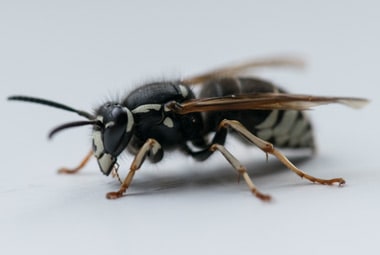
Despite their name, baldfaced hornets are actually relatives of yellow-jackets and paper wasps. They are referred to as hornets only because of their large size and also because their nests are high up off of the ground. They are social wasps that live in large colonies and have a social structure that is similar to that of honey bees and ants.
| Pest Identification | |
|---|---|
| Recognition | Baldfaced hornets are black in color with an off-white colored pattern on most of their face and on the end of their abdomen. They have a long-thin wasp-like body. Adult workers grow to be ½ to 5/8 of an inch in length. The queens are larger and can be ¾ of an inch in length. |
| Biology | Baldfaced hornets have a four-stage life-cycle, egg larvae, pupa, and adult. A baldfaced hornet colony only lasts for one year and everyone but the new queens die. The colonies are started in April or May when the overwintering queen emerges to search for a suitable location to build a nest. Inside of the new nest are cells. In each cell, the queen lays an egg and places with it insects and nectar for the newly hatched larvae to feed on. Those first eggs develop in sterile adult females who act as workers. Their job is to increase the size of nest, forage for food, and care for new offspring. The queens’ job is to continue laying eggs to increase the colony size. By mid-summer, the colony is at its peak, with each colony generally having 100-700 workers. When the cooler weather of fall comes back around, males and new queens are produced. Their main purpose is to mate in preparation for the spring. The males, old queens, and workers die off in the winter weather. The newly fertilized females remain safe by hibernating over the winter. The young queens then emerge once again in the spring to build a new nest and start the life-cycle over. |
| Habits | Baldfaced hornets commonly place their aerial nests made of paper in trees, on utility poles, under house eaves, or on the side of any building. Their nest can become very large, some getting as big as a basketball. Baldfaced hornets are considered to be beneficial insects because they prey on flies and other nuisance insects. Adults have a liquid diet and feed on sugary liquids like juices and nectar. The workers collect insects to bring back to the colony for the larvae to feed on. |
| Prevention | Preventing baldfaced hornets from choosing your property to nest on can be very difficult to accomplish. It is impossible to dictate whether a queen will choose a tree on your property or your home for her new nest. The best way to prevent problems with baldfaced hornets is to contact a professional pest control expert to come and remove a nuisance nest if it has become a safety issue for you and your family. If they have built a nest high up in a tree or somewhere else out of the way it is best to leave it alone since they are beneficial insects and help to control nuisance insect populations. |
| Professional | If a baldfaced hornet nest has become problematic on your property you should contact Rottler. One of our experienced pest management professionals will come to your property and preform an inspection. They will then work with you to decide which treatment option is most appropriate to eliminate the baldfaced hornet presence. Either labeled aerosol or dust insecticide will be used to treat and eliminate the colony. Our professional will wear protective garments and use dust sticks, or bee poles to help guarantee the safe removal of the nest from your property. |

